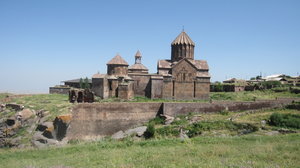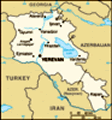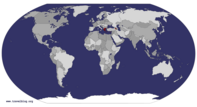Advertisement
Published: July 20th 2010

 The Monastery at Harich
The Monastery at Harich
Standing on the other side of the ravine-- though soaked-- I was safe to take out my camera and snag a picture of the monastery. Some aspects of later European gothic architecture are recognizable in the 7th century building.After a busy , but fantastic week, I'm squeezing in a few minutes to write this blog entry before dinner, data processing, email checking, and last, but certainly not least, bed. I'm also not holding up to my promise to write once a week -- but I hope to post twice this week to make up for it. (One final caveat: I didn't get around to posting this on Sunday (7/18) when I wrote it, and I'm finally posting it on Tuesday (7/20), that's why dates may seem a bit off.)
After finishing the week up in the field, last Saturday (we work Monday through Saturday, and have Sunday off, which is reserved for field trips, and general mental well-being), we ventured off to visit three sites north west of Aparan and the Tsaghkahovit plain where we spend our weeks in the field. In addition to being a field trip day, it also happened to be Vartavor, an Armenian holiday, which is based around the throwing of as much water as possible, on as many people (and/or cars) as possible (think buckets, bottles, Super Soakers, puda-pudas, etc. in the hands of children, with a State/Church sanctioned blessing to soak

 Defensive Wall A at Horum
Defensive Wall A at Horum
The lower courses of this wall are massive (Adam, Ruben, Hannah and Katie act as a scale), and they represent just one of the three circuit walls which surround the fortress. One theory suggests that aside from being practical defensive constructions, these walls also telegraphed the king's wealth and ability to command the labor necessary for their construction.whoever crosses their path). The origins of the holiday are debated-- either as a way of celebrating the baptism of a saint, or as a pagan water ritual-- but in either case, it resulted in sopping wet Americans, and very pleased Armenian children...
Our first stop was the monastery at Harich, which was constructed in the 7th century AD during what is commonly referred to as the Armenian Renaissance, and a time period when the fortress town of Ani, "The City with A Hundred Churches," and now in Turkish territory, was built. Adam explained to us that some Medieval scholars believe that the architectural styles of the European Renaissance, were at least partly indebted to the Armenian Renaissance-- because while Europe was in the depth of the Early Middle (read: Dark) Ages, Armenia was experimenting with architectural styles, and in many cases, saving what was left of the intellectual property of the Classical World.
We walked through the monastery which is experiencing ongoing restoration by the Armenian Orthodox Church, into the church, where we witnessed part of a religious service-- and stayed dry. So far, so good. The problem really started when we climbed down from the monastery into the

 Aragats from the Citadel at Horum
Aragats from the Citadel at Horum
In addition to three circuit walls, Horum sits atop a very steep hill, making it even more impervious to attack. In the distance, Aragats, the tallest mountain in Armenia, and the namesake for the project is visible.gorge on which it sits, en route to the Bronze Age archaeological site located on the other side. It just so happens, however, that this gorge was cut by a small river, which was a beautiful spot for family holiday barbeques and also provided a never ending supply of ammunition for children lying in wait for us. As we crossed the bridge over the little stream, Ruben, who is an old pro at dealing with Vartavor hooligans tried to run interference for us rookies, and would have gotten us across safely if a few clever kids hadn't snuck around behind us, and got me and one of the other graduate students squarely in the back with two well aimed buckets of water. Good thing my camera was in its case. Luckily, by the time we began climbing the other side of the ravine the children had used up all their water, and had to run back to the river (and away from us) to reload, and we climbed to the top thinking we were through the worst of it. To our surprise (and chagrin) a 15 or 16 year old kid had climbed up another path, out of our view,

 Tactical Planning and T22
Tactical Planning and T22
Trench 22 in the foreground, some of which was excavated in 2008, and Adam, Ruben and Roman (our paleobotanist) considering our next plan of action. By using the soil section from the trench dug in 2008, we can figure out approximately how deep certain soil and cultural layers should be and plan out attack accordingly. In this case, we're trying to sort out how deep the destruction level is.and was waiting for us on top with another bucket full of water. Ruben, again, ran at the kid (which momentarily surprised him and caused him to spill some of the water), but once he had oléd Ruben, poor Connor (a graduate student from Purdue) got drenched. We would face a similar onslaught on our way back across the ravine on the way back to the car.
The Bronze Age site of Harich, a small portion of which was excavated in the 1960s and 1970s, is massive-- and though without excavation or a remote sensing survey we can't know its precise extent, estimations are between 5 and 6 hectares (12-14 acres). It has a large citadel, and a very significant cemetery (which was the focus of the excavations in the 60s and 70s), and is a potential candidate for future work by the ArAGATS project which I've become a part of for the summer. If sheer size alone isn't interesting enough, an Early Bronze Age burial and shrine were discovered when the site was excavated-- the burial was of an old man, surrounded by religious-type ceramic vessels, and situated beneath a shrine to a frog (which I find particularly interesting

 Trench 27
Trench 27
The whole jar is visible in the foreground, and a strange stone box in the background (we're not sure what this was for yet). The trench itself is 5 m x 10 m, but the area we've been focusing on (called a "locus" in archaeological terminology) is only about 5 m x 4 m.since frogs -- unlike say, eagles or lions-- aren't exactly the sort of animals one dreams about being associated with for eternity...).
After Harich, we stopped in a nearby park for a beer/water before heading off to two additional sites. Sitting outside on Vartavor? Big Mistake. Not ten minutes passed before a roving band of young boys (10-15 years old) smelled the blood in the water, and attacked, each armed with a bucket of water. Somehow, I was able to avoid the worst of it (without actually trying... I just sat there, and they just missed me), but poor Connor and Katie got soaked. To their credit, they did fight back, spraying as much water from their water bottles as possible on their attackers. For the rest of the day, Vartavor consisted of our car being splashed by road-side ambushes, but no one in particular got wet again. It did lead to extended conversations (particularly between Connor and I) about was sort of ammunition we should plan to bring back next year, if we come-- let's just say I'll need a bigger suitcase for water guns and super soakers.
Next, we visited Beniamin, a site occupied during the Persian and Hellenistic periods. Although there wasn't much to see in the way of excavations, learning about the Persian and Hellenistic occupations of Armenia was fascinating. Apparently the Persians saw Armenia as a major source of war horses (akin to the way the Chinese viewed Tibet during the Song dynasty, http://ngm.nationalgeographic.com/2010/05/tea-horse-road/jenkins-text) and as such, the region was highly prized. Part of the ArAGATS excavation at the site of Tsaghkahovit (where Lori and Katie are excavating) is interested in better understanding the Persian occupation there, since Tsaghkahovit seems to have been the regional capital. Beniamin probably was set up in order to control an important east-west trade route which passed near it (and may have been how some of the Armenia horses were transported). The Hellenistic occupation (during the time period after Alexander the Great attacked and took control of the Persian Empire) was less significant, and as such, less is known about it-- in some ways Armenia was off the beaten path for the Seleukid kingdom of the Near East, of which it was a part (Seleukus was one of Alexander's top generals who took control of the Near Eastern/former Persian part of Alexander's empire after he died in 323 BCE). It seems like Seleukus decided to maintain the Persian system of control over the region, opting to throw his support behind the local ruling family, instead of setting up his own nobles, and opening a whole new can of worms.
Our day finished at Horum, an Uratian period site, on our way back to Aparan. The site itself is one of the most impressive I've ever seen, sitting atop two adjacent hills, and surrounded by three circuits of massive fortification walls. The Urartians controlled the Caucasus (modern day Azerbaijan, Armenia and southern Georgia) during the early Iron Age (9th-6th centuries BCE), and really represent the most powerful Armenian Empire until the 7th century AD. Horum attests to just this. Covering an area roughly 10 hectares in size (24 acres), it is a dramatic fort which again (like Beniamin) seems to have controlled a major trade route between the Tsaghkahovit plain and points south, and the Shirah plain and points north-west. The Urartians (who Adam often describes as "pirates and raiders") were a tremendous military people, who probably based much of their power and wealth on the control of the copper and gold mines in Armenia, in addition to controlling the fertile highland plains and livestock rearing territory. In any case, Horum is a tremendous site, and one which has only been partially excavated (Ruben commented: "this site took at least a lifetime to construct, and will take many more lifetimes to excavate"), and actually was the first site Adam worked at in Armenia almost fifteen years ago.
By 5 PM we had returned (and by this time dry) to Aparan, in time to take a short rest, and then go out for a traditional Khorovats (Armenian for BBQ) dinner. We went to a local restaurant, which is built into the side of the hill, and ate in a private dining room which actually was a man-made cave. It was a very nice evening (complete, of course, with a substantial amount of vodka), I was happy to get some rest that night. All in all, a great day.
The rest of the week saw us up at 7 AM to get ready for the field, breakfast is at 8, and we usually make it to the sites by 9 or 9:15, and work until 4 PM, after which we enter excavation information (including the location of artifacts, elevations of cultural levels, and an explanation of what happened in our various excavation trenches during the day), have dinner, and usually relax and enjoy beautiful evenings at night. In the trenches (so to speak) we've finished working in T22, though we did spend longer in there than I had expected-- after a lot of Early Bronze Age (EBA) pottery, we were hoping we might find an EBA wall of some sort, but instead were only rewarded with a seemingly never ending pile of rocks. We've stopped there for now, and focused all attention (and workers) on T27-- where the excitement is. Friday afternoon, after digging through about 45 centimeters (archaeologically speaking, quite a deep level) of an ashy layer, one of my workers came across the lip of a large jar, and after a few minutes of cleaning, it became clear that the jar itself was entirely intact, and entirely empty. It is very rare for jars to be found whole, and even more rare for them to be empty since as soil is deposited, it almost always fills the ceramic vessels lying in the ground-- but for some reason (as yet unknown to us, though I have my suspicions... stay tuned...) this vessel was large, intact, and totally empty. However, we left it in situ until Monday so we can take photos, and better understand the sorts of vessels that might be around it. On Saturday, we were able to uncover three more vessels -- larger this time, and while they are broken, all their pieces seem to be in place. The plan is to bring out paleobotanist out tomorrow (Monday), and remove this vessels, along with their contents (by this time mostly soil) in order to analyze the pollen and seed content of the soil, so we can determine (or hope to determine) the sorts of things stored in these ceramics. We've also found a number of large, charcoal beams, which indicate that the region I'm excavating was heavily burned, resulting in the site's abandonment, and the pots being left for us to discover.
Well, this is getting long, and I'll be writing another entry in a few days, so until then, stay tuned. More to come from T27 --and my weekly adventures in Armenia. Hope everyone is well, and enjoying the summer!
All the best,
Jeff
Advertisement
Tot: 0.087s; Tpl: 0.012s; cc: 9; qc: 48; dbt: 0.0557s; 1; m:domysql w:travelblog (10.17.0.13); sld: 1;
; mem: 1.2mb









Aunt Maggie
non-member comment
Hey Jeff!! Again I really enjoyed reading this blog. I would definitely take any course you were teaching ....even though there's a lot I don't get, you make it sound really interesting. Oh, about preparing for next year's Vartovar...you know how they always show small suitcases with multiple size weapons .. all of then disassembled and fitting snugly and discretely in a small container ... well you should figure out a way to disassemble a super soaker or puta puta and then re-assemble it at your destination .... become next year's Vartovar Hit Man (so to speak)....anyway that sounded like fun (glad your camera was protected). Anyway, another great blog, I enjoyed learning as I was reading. TAke care, see you in August.